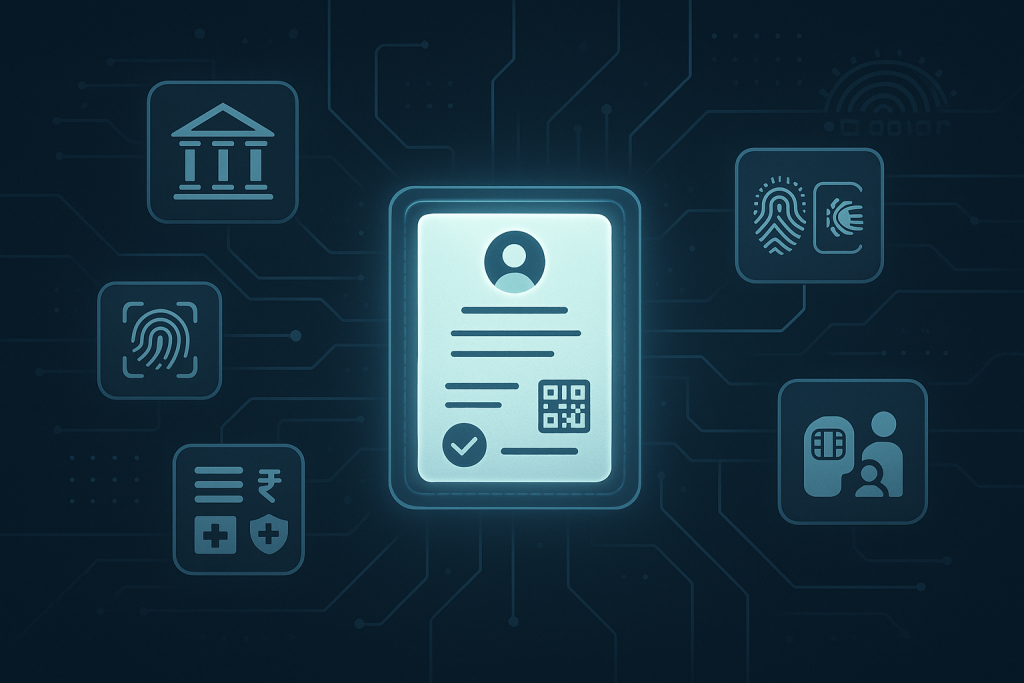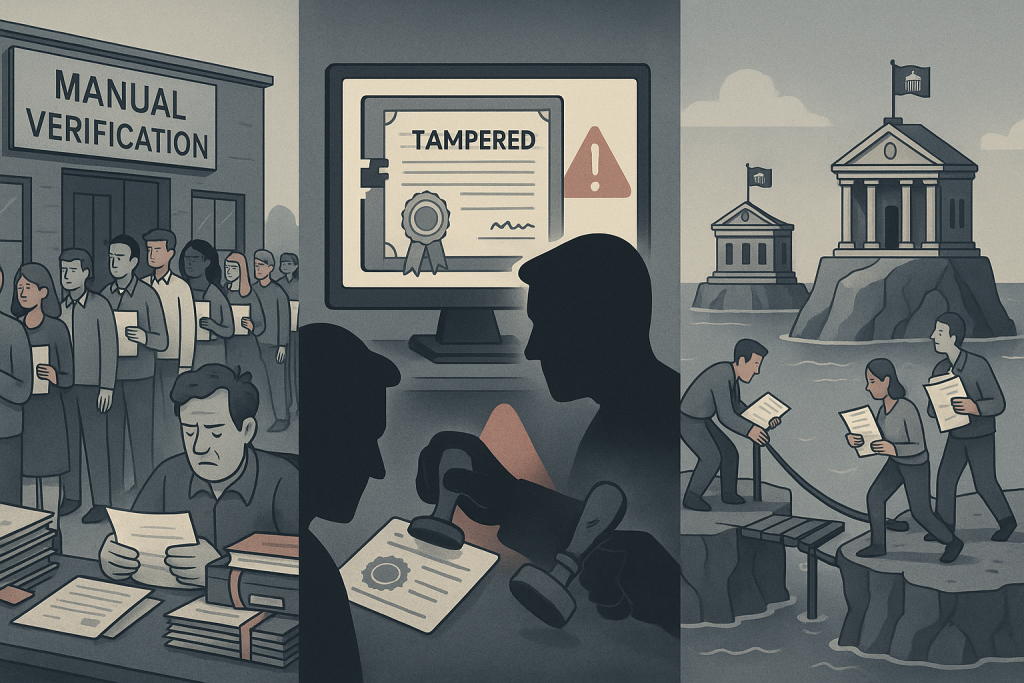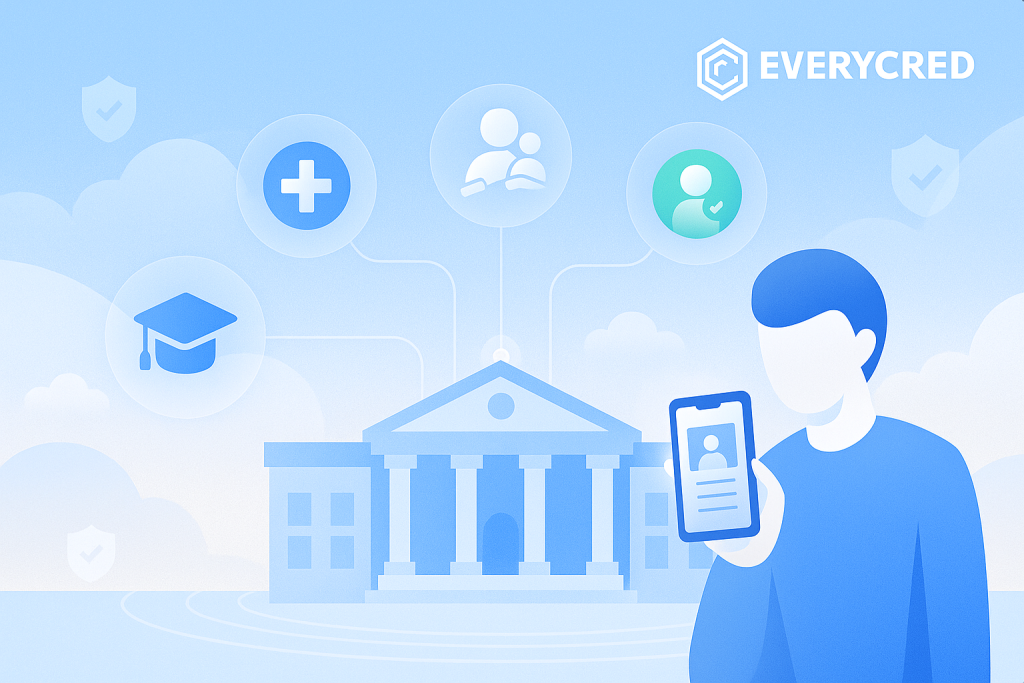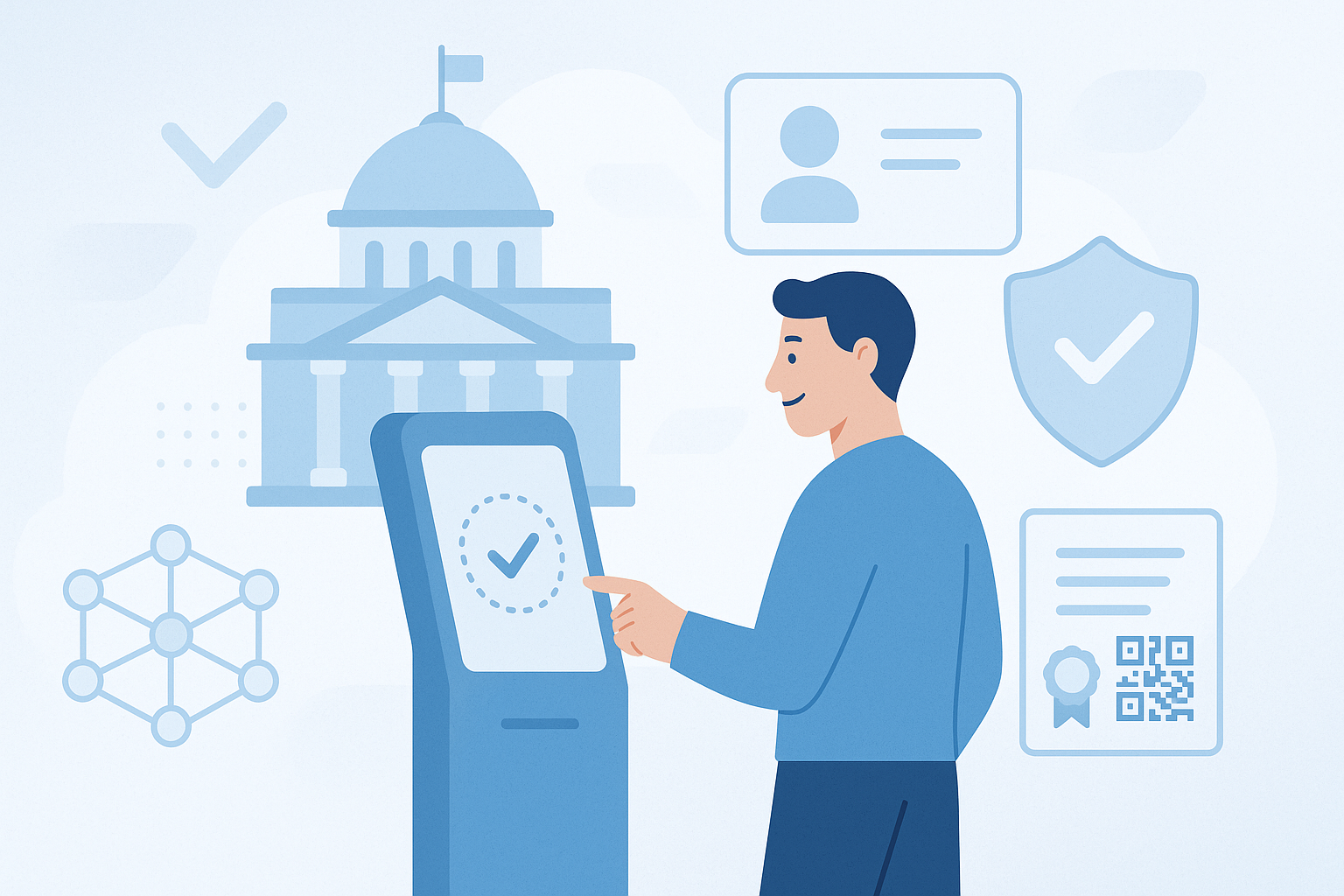Trust in public services is wearing thin and the reasons are not surprising. Long queues, repeated paperwork, missing documents, and opaque verification processes have eroded citizen confidence in how public institutions function. In a world where people can access banking, healthcare, and communication at the tap of a screen, interacting with public services often still feels like stepping back in time.
One of the biggest culprits? Manual verification systems. Whether it’s verifying identity, validating eligibility for welfare programs, or authenticating educational qualifications, most public service workflows rely on paper-based or PDF-based records that are easy to forge, hard to trace, and time-consuming to process. Tampered documents, lost files, and inter-departmental silos have made public recordkeeping both inefficient and untrustworthy.
The global e-Government market was valued at USD 28.1 billion in 2022, and is expected to expand at a CAGR of 14.5% from 2023 to 2030, driven largely by demand for efficient, transparent, and citizen-centric public services.
Citizens are growing impatient. They expect digital-first governance, but receive analog-era experiences. The result: a widening trust deficit between people and the systems meant to serve them.
But what if this could change?
What if trust could be restored not through more bureaucracy, but through technology that empowers both citizens and public institutions?
This is where verifiable credentials come into play, a new layer of secure, tamper-proof, and citizen-owned digital records that can fundamentally rewire how public trust is built and maintained.
What Are Verifiable Credentials in Public Governance?

Verifiable credentials are secure, tamper-proof digital records that can be issued by a trusted authority, held by the citizen, and instantly verified by any authorized entity without the need for repeated paperwork or manual validation.
In simpler terms, they’re like digital ID cards or certificates that carry built-in authenticity. Unlike a traditional document (say, a scanned caste certificate or a PDF of an income certificate), a verifiable credential is cryptographically signed and cannot be altered without detection. It comes with embedded metadata that proves who issued it, to whom, and for what purpose all in a privacy-preserving, machine-verifiable format.
Real-World Examples:
- ID Proofs: Aadhaar-linked credentials for identity verification
- Caste Certificates: Issued by local authorities for welfare eligibility
- Health Records: Vaccination credentials or digital health IDs
- Education Records: Mark sheets, degrees, and training certificates
- Disability Cards or Income Proofs: For targeted social schemes
DigiLocker & India Stack: Setting the Stage
India is already ahead in laying down digital public infrastructure through initiatives like DigiLocker, which stores official documents in digital format. However, most current records in DigiLocker are static files PDFs or scanned images not verifiable credentials.
With support from the India Stack and emerging digital trust frameworks, DigiLocker is evolving into more than just a storage system, it’s becoming a platform where credentials can be issued, held, and verified with built-in trust.
This shift unlocks massive potential for GovTech innovation, where every document from a birth certificate to a business license can become a verifiable, interoperable, and reusable trust asset.
Why Trust Is Broken: Manual, Centralized, and Vulnerable

For all the progress in digital governance, many public services still rely on outdated systems that are prone to errors, inefficiencies, and misuse. Trust breaks down when citizens experience inconsistencies, delays, or are asked to prove their identity or eligibility multiple times often with the same set of documents.
Manual Verifications Are a Bottleneck
From ration card applications to pension claims, manual verification processes create unnecessary friction. Officials must cross-check documents physically, match paper trails, or wait for responses from other departments. This not only slows down service delivery but introduces human error and bias.
Document Tampering and Forgery Are Real Threats
In the absence of tamper-proof mechanisms, digital files like PDFs or images can be easily edited. Whether it’s tweaking a birthdate on an ID or altering income data to qualify for a scheme, forgery remains a serious governance challenge, leading to misuse of public funds and exclusion of deserving beneficiaries.
Centralized Silos Prevent Seamless Service
Most government systems are department-specific and disconnected. A certificate issued by the rural development office might not be recognized by the housing board without fresh verification. This lack of interoperability erodes efficiency and frustrates citizens who must constantly act as intermediaries between departments.
The result? A public service ecosystem where citizens feel burdened, officials are overwhelmed, and trust erodes at every stage of interaction.
Fixing this requires more than digitization, it requires digital trust infrastructure built on verifiable credentials.
How Verifiable Credentials Can Restore Trust in Public Services
To rebuild public confidence, governments must go beyond digitizing forms, they must digitize trust itself. Verifiable credentials do exactly that by making public records secure, portable, and instantly verifiable, putting citizens back in control of their identity and entitlements.
Here’s how:
1. Tamper-Proof Public Records
Every verifiable credential is cryptographically signed by the issuing authority. This means the data inside like your caste certificate or income proof cannot be edited or forged without breaking the signature.
No more fake documents. No more guesswork for verifying officers.
2. Frictionless Verification for Government Services
Instead of asking citizens to submit photocopies or scanned files every time, departments can verify credentials instantly even across states or ministries.
Example: A housing board can instantly check the validity of a disability card issued by the health department, no calls, no forms, no delays.
3. Portable, Citizen-Controlled Credentials
Citizens store their credentials in digital wallets, such as DigiLocker, and share them with consent when needed.
- No more submitting the same documents for every scheme.
- No more risking privacy by oversharing.
This empowers citizens while reducing administrative load.
Together, these capabilities enable a new kind of governance, one where trust is verifiable, not assumed, and public services are built for efficiency, inclusion, and integrity.
DigiLocker & the Rise of Digital Trust Infrastructure

India has laid a strong foundation for digital governance through initiatives like DigiLocker, a platform that allows citizens to store and access official documents issued by government departments. With over 200 million users, DigiLocker is already a cornerstone of India’s e-Governance ecosystem.
But storing documents digitally is only the first step. The next evolution is transforming these documents into verifiable credentials, cryptographically secure, interoperable, and instantly trustable across departments, platforms, and states.
From Digital Storage to Verifiable Credentials
Today, most records in DigiLocker are static PDF files or scanned images. They may be convenient to store, but they still require manual validation and are prone to forgery or tampering.
The shift toward verifiable credentials means these same documents can be:
- Digitally signed by the issuer
- Tamper-evident and privacy-preserving
- Instantly verifiable without re-authentication
This turns every document a school certificate, income proof, or land record into a trust anchor that’s portable and secure.
Powered by India Stack and Digital Public Infrastructure
This transformation is made possible by the broader vision of India Stack, a suite of APIs and open standards that enable scalable, secure, and inclusive digital services. DigiLocker, Aadhaar, eSign, and UPI are all components of this growing digital trust infrastructure.
By integrating verifiable credentials into DigiLocker, India can lead the world in GovTech innovation showing how a billion citizens can participate in digital governance with dignity, privacy, and trust.
Use Cases That Matter: Impact Stories in the Making
Verifiable credentials aren’t just a technological upgrade, they’re a catalyst for transforming real lives. Across sectors, they can eliminate bottlenecks, protect citizens’ rights, and ensure that government programs reach the right people, faster and more securely.
Here are some high-impact use cases where verifiable credentials can make a measurable difference:
Government ID Programs
Issuing IDs like Aadhaar, voter cards, or ration cards as verifiable credentials ensures that identity is tamper-proof and portable.
A migrant worker can present their verified ID in another state without resubmitting documents or risking rejection.
Social Services & Welfare Schemes
Income certificates, caste documents, and disability cards are often prerequisites for accessing government benefits. When issued as verifiable credentials, these documents can be instantly verified by welfare officers, cutting delays and fraud.
Example: An applicant for a housing subsidy can digitally share their verified income and disability status, no paper chase.
Education Credentials
Degrees, diplomas, and mark sheets are frequently forged or delayed. With verifiable academic credentials, educational boards can issue secure, tamper-evident records that students can present to employers or other institutions with confidence.
Saves institutions from duplicate issuance and manual verifications.
Health Services
Vaccination records, digital health IDs, or disability status can be issued as verifiable credentials especially useful during emergencies, insurance claims, or inter-state treatment.
Citizens control access, and data privacy is preserved.
These use cases demonstrate one thing clearly: when credentials become verifiable, services become trustworthy. The benefits ripple outward from smoother workflows for administrators to greater dignity and ease for citizens.
What’s Holding Governments Back? Barriers to Implementation
While the case for verifiable credentials is strong, their adoption in public services isn’t without challenges. For many government agencies, the shift from traditional documentation to trust-based digital systems can feel complex, even risky.
Here are the key barriers slowing down widespread implementation:
Legacy Systems and Infrastructure
Many government departments still operate on decades-old software and paper-based workflows. Integrating modern credentialing systems with outdated infrastructure often requires significant IT upgrades, system redesigns, and process re-engineering.
Regulatory and Policy Ambiguity
The legal and policy frameworks around digital identity and data sharing are still evolving. Without clear standards, interoperability norms, or legal recognition for verifiable credentials, decision-makers hesitate to move forward.
Integration Complexity
Verifiable credentials require coordination across multiple agencies, data registries, and identity systems. This complexity makes departments fear disruption or loss of control especially where internal silos and bureaucratic resistance are strong.
Cultural Resistance to Change
Digital transformation is as much about mindset as technology. Public officials may be unfamiliar with concepts like decentralized identity or credential wallets. Without targeted capacity building and success stories, adoption slows.
Addressing these barriers calls for trusted technology partners, supportive regulatory frameworks, and a phased rollout approach proving value step-by-step.
How EveryCRED Supports Digital Trust for Governments

Solving the trust crisis in public services requires more than just issuing digital documents, it requires building a secure, interoperable, and citizen-centric credentialing ecosystem. That’s exactly what EveryCRED delivers.
Built with government-scale complexity and public trust in mind, EveryCRED enables departments, agencies, and ministries to issue, manage, and verify digital credentials with confidence while staying compliant with national and global standards.
Designed for Public Sector Needs
Unlike generic credentialing tools, EveryCRED is purpose-built to meet the unique demands of GovTech ecosystems, including:
- Multi-department integration: Seamlessly connect health, education, social welfare, and ID registries
- Consent-based credential sharing: Citizens decide who can access what, protecting their privacy
- Offline verification: Enables credential validation in rural or low-connectivity areas
- Scalability: From small pilot programs to nationwide rollout
- Standards-compliant: Built on W3C VC, DID, and aligned with frameworks like India Stack.
Security and Compliance at the Core
EveryCRED ensures:
- End-to-end encryption for credential issuance and transmission
- Zero-knowledge proofs for privacy-preserving verifications
- Tamper-evident data with cryptographic signatures
- Audit logs and dashboards for transparency and governance
Accelerating Implementation
Whether it’s integrating with DigiLocker, enabling verifiable ID cards, or digitizing welfare eligibility, EveryCRED offers modular APIs, sandbox environments, and deployment support helping governments go from vision to verified in weeks, not years.
From policy designers to program implementers, EveryCRED is the partner of choice for those serious about building digital trust at scale.
Getting Started: A Roadmap to Citizen Credentialing
Adopting verifiable credentials doesn’t require overhauling every government system overnight. In fact, the most successful implementations begin with targeted, well-scoped pilots that build confidence and demonstrate measurable outcomes.
Here’s how GovTech leaders can move from concept to reality:
Start Small with High-Impact Pilots
Identify departments or programs where verification burdens are high and citizen touchpoints are frequent such as welfare schemes, disability services, or student certificates.
These are ideal proving grounds for the value of verifiable credentials.
Leverage Existing Infrastructure
Build on what already exists. DigiLocker, Aadhaar eKYC, and departmental data registries can serve as the foundation. Use APIs and plug-ins to connect these systems with a verifiable credential layer.
This reduces development time and ensures smoother adoption.
Prioritize Interoperability and Standards
Choose credentialing partners that support open standards like W3C Verifiable Credentials, DID, and protocols aligned with India Stack or eIDAS. This ensures the system is future-proof, scalable, and vendor-neutral.
Focus on Citizen Experience
Make sure citizens can easily access, store, and share their credentials using familiar platforms like DigiLocker or mobile apps. Provide multilingual support and offline access to maximize inclusion.
Measure and Scale
Track outcomes such as reduced verification time, lower error rates, and improved citizen satisfaction. Use data to drive stakeholder buy-in and plan for gradual expansion across more departments.
EveryCRED supports each step of this journey from pilot to platform ensuring your digital trust infrastructure grows securely, responsibly, and at scale.
Final Thoughts: Public Trust Is a Design Choice
Rebuilding trust in public services isn’t just a policy problem, it’s a technology opportunity. By adopting verifiable credentials, governments can create a digital ecosystem where trust is no longer assumed, it’s proven, secure, and citizen-owned.
From faster welfare delivery to fraud-resistant identity systems, the benefits ripple across departments, programs, and most importantly, people. With platforms like DigiLocker and frameworks like India Stack, India is uniquely positioned to lead the world in building digital trust at scale.
But it requires bold steps.
Take the Next Step
Partner with EveryCRED to bring verifiable credentials into your governance stack.
Fill out the inquiry form and explore how we can help you launch secure, scalable, and citizen-first credentialing solutions.

 17th July, 2025
17th July, 2025 



